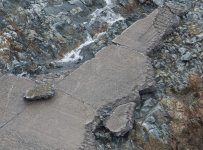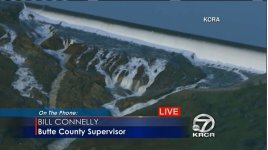
Take a look at the photo above. It comes from the
Metabunk web site, about half way down the cited page. It shows the bottom of the hole in the spillway after the first time DWR stopped the water flow. The stone is gray, not green, like the serpentine in this area. To me, that makes it limestone. I say this for a few reasons:
I live on the bank of the West Branch of the Feather River, upstream from the dam site, and both green serpentine and limestone can be found in abundance under my property. Bands of these limestone outcroppings can be observed in the canyon wall from the bridge that crosses the West Branch a few miles closer to the dam than my home. A marina nearby is named Lime Saddle, and back in the '20s limestone was mined and converted to cement in kilns that can still be found downslope from my property. Unfortunately, my well is drilled into that limestone, and as a result the harness of the water is very high.
When the serpentine around here gets wet, it turns dark green. Since the photo was taken shortly after the water was shut off, it is reasonable to conclude that the rock shown is wet. Another photo located closer to the top of that same Metabunk page shows water dripping off the broken spillway concrete and two workers in the hole, one of them in full raingear. The rock in both photos does not show the dark green color that is characteristic of the serpentine in this area. It's gray, same as the limestone on the canyon wall when it gets wet. It's been wet a lot this winter, and I pass over that bridge and look at it every time I head into town.
Very likely there is serpentine in the area that the dam was built, but I don't see any in the photo. It's limestone.
Somewhere is a geologic survey map of the Oroville Dam area, but I've been unable to find it online. I did find one for the Auburn Dam, and areas of serpentine are clearly marked.
But what difference does it make what the rock is for the purposes of this discussion? The original concern was that the spillway was built on earth fill, which would rapidly erode back to the reservoir once the concrete broke. That is clearly not the case, so perhaps we can come to agreement over that and move on?


